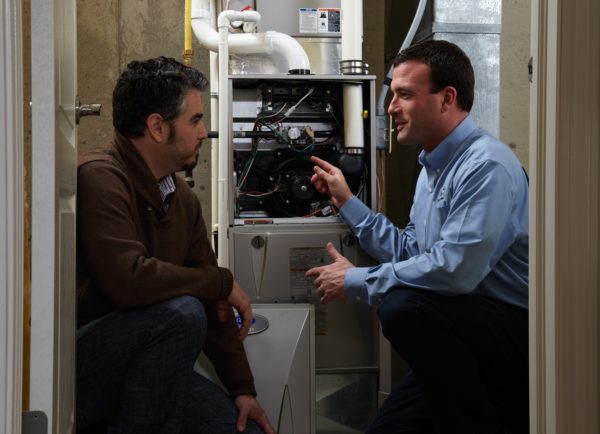
When looking at having your furnace replaced, there are a few important factors to consider. This includes the overall efficiency rating of the furnace as well as whether it is a single- or two-stage or variable-speed unit. To help make your choice easier, here is a full overview of two-stage furnaces including how they work, how they compare to other options and what benefits they can provide.
How a Two-Stage Furnace Works
Most gas furnaces are single-stage units, which means that they can only run at full power. Whenever the unit is on, the gas valve opens fully and the unit always produces its maximum amount of heat. It will then continue to run at full power until the set temperature is reached and the furnace shuts down.
Two-stage furnaces can run at both high and low power. The high setting is always 100% while the low setting is usually somewhere between 60% and 70%. To run at lower power, two-stage furnaces use a three-way gas valve.
In a single-stage furnace, the gas valve only has two settings, fully open or closed. The three-way gas valve in a two-stage furnace has an additional setting where the valve is only partially open. This reduces how much gas flows into the unit and lessens the amount of heat created at one time. As a result, the furnace will generally run for longer periods while producing less heat.
When a two-stage furnace starts, it always runs at the lower setting at first. If the temperature inside the building is well below what the thermostat is set to, the furnace will then switch over to run at full power until the temperature starts to rise. Once the thermostat detects that the temperature is warm enough, it will signal the furnace to again run at the lower setting.
On milder days, the furnace will usually run only at the lower setting. This is one of the reasons why two-stage furnaces are a great option for places like Texas that typically don’t experience extremely cold temperatures. In northern climates, the furnace would often still need to run at full speed on colder days. In milder climates, the furnace will almost always run at the lower speed, using less energy.
It is important to understand that a two-stage furnace is not the same thing as a variable-speed or modulating furnace. Although both types of units can run at a lower speed, they work in different ways. With a two-stage furnace, only the gas flow is reduced. Variable-speed furnaces, on the other hand, can also slow down the speed of the blower fan. They also have more than two settings and can usually run at anywhere from 40% to 100% capacity. With all of the technical information out of the way, let’s take look at the various benefits that two-stage furnaces can provide.
Lower Heating Costs
This is the most obvious of all the benefits. By reducing how much gas the unit burns at one time, two-stage furnaces will directly contribute to lower heating costs. Even though two-stage furnaces will typically run for quite a bit longer and more frequently than single-stage furnaces, they still use less energy since they don’t burn as much gas at one time.
Longer Lifespan
The fact that two-stage furnaces run for longer periods makes it even more essential that you have your system maintained every year. If not, that extra time will put more stress on the HVAC blower and could cause it to wear out more quickly. That being said, two-stage furnaces do typically have a slightly longer lifespan than single-stage furnaces.
The main reason is that the furnace experiences less stress and wear and tear due to running at a lower speed. The other reason has to do with the furnace not turning on and off as frequently. Furnaces and other HVAC units typically need to work much harder in the first few seconds while turning on. Minimizing the number of times that the furnace turns on and off also reduces this strain and lessens the overall wear and tear.
More Even and Consistent Heating
Another issue with your furnace turning on and off frequently is that it often leads to more temperature fluctuations. This problem can be especially pronounced in multi-story buildings and leads to some parts of the home always staying much colder or hotter than other areas.
In many cases, the system will shut off before the entire building is fully heated. This leads to the basement, lower levels and rooms on the perimeter of the building always being colder. With a single-stage furnace, the only way to overcome this issue is to set your thermostat to a higher temperature, which can then lead to other parts of the building being too hot.
Two-stage furnaces can help to eliminate these problems since they will continue to produce lesser amounts of heat instead of simply running for a few minutes at full blast. This means more consistent heating and temperatures throughout the entire building.
Quieter Operation
A major benefit to two-stage furnaces is that they produce much less noise. With a single-stage furnace, you will often hear a loud noise as the gas inside the unit first ignites. This typically isn’t the case with a two-stage furnace since it will always start at the lower setting.
The furnace will also produce less noise while it is operating since it isn’t working as hard. That being said, the noise level will still be the same whenever the furnace is running at 100% power.
Improved Indoor Air Quality
Two-stage furnaces can also help to improve your home’s indoor air quality. Your furnace filter primarily works to trap debris from getting inside the system and potentially gunking it up and damaging the various components. However, it also filters out dust, pet dander, dust mites, hair and other contaminants so that they are not circulated throughout the home whenever your furnace runs.
Since a two-stage system will usually run for longer periods, it will also be much more effective at filtering allergens and contaminants out of the air. As more air is drawn through the filter and circulated throughout the building, more particles will be removed. This will provide occupants with better air quality. Of course, this does also mean that your air filter will likely get dirtier more often and need to be replaced on a regular basis.
Expert HVAC Services in San Antonio
If you’re looking to upgrade or replace your furnace, Beyer Air Conditioning & Heating is here to help. We install all types of furnaces as well as central air conditioners and ductless HVAC units. Beyer Air Conditioning & Heating also specialize in heating and cooling maintenance and repairs and indoor air quality equipment. Our team is expertly trained to provide trustworthy service to those beginning new construction projects as well as remodels, and we can help with duct cleaning and repairs too. If you have any questions about your options for furnace installation or need any HVAC service, contact Beyer Air Conditioning & Heating today.



